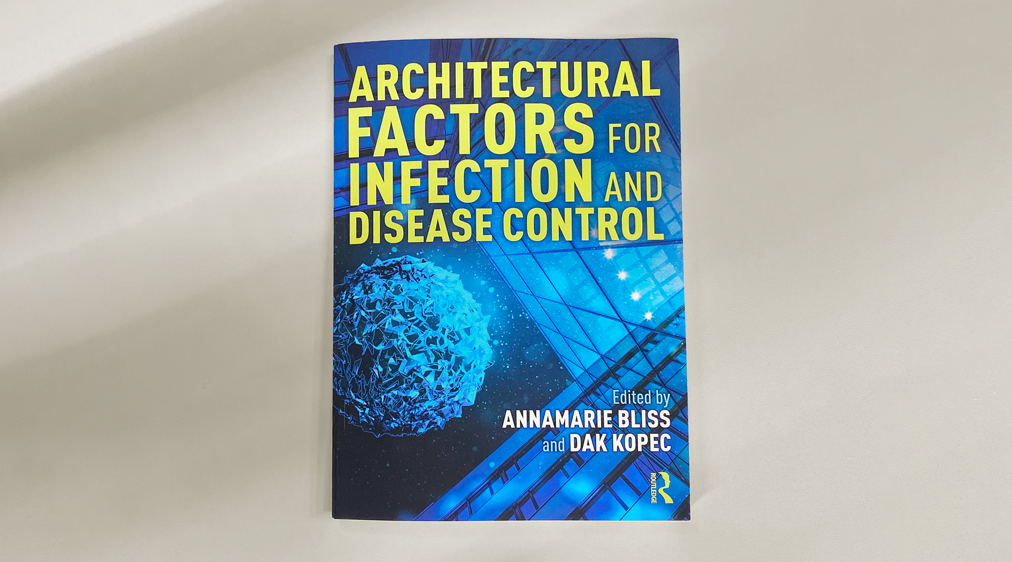With 45 years of experience dedicated exclusively to healthcare facility planning, programming, and design, and more than 200 healthcare facilities across the world built in his vision, John Currie, FAIA, FRSPH, RIBA, EDAC is not only a prolific healthcare architect but also a public health aficionado. From community hospitals to academic medical centers, specialty hospitals, and cancer care facilities, he is consistently noted among the leading experts in healthcare facility development.
John joins a number of other noted public health authorities in a newly published collection of essays, Architectural Factors for Infection and Disease Control, edited by Dak Kopec, Ph.D. and AnnaMarie Bliss. The book is, at its core, an exploration of disease transmission and its effects and influences on designed environments. In the constantly changing world of healthcare, insights into past and present design are paramount to a successful future. John sheds light on this and more in his chapter entitled ‘Isolation, Quarantine, Infection Control: Architecture and Planning in Service to Public Health’. We had the pleasure of discussing the chapter with John, digging deep into his personal interest in infection control and what it means in context of designing healthcare spaces today.

Tell us a little bit about your background and your specific interest in infection control.
I have been in the world of planning, programming, and designing health care facilities for well over 40 years. I received a graduate architectural degree in health facilities design with a minor in hospital administration, and served as a Medical Service Corps Officer in the US Army where part of my training was as a field medic. Since then, I have been privileged to use the skills I’ve learned to carry out health-related design projects all over the world.
I have been a member of The Association for Professionals in Infection Control and Epidemiology (APIC), the Royal Society for Public Health (RSPH), and the Association for the Advancement of Medical Instrumentation (AAMI) for over 25 years, and hold a Graduate Certificate in Public Health.
I believe that understanding infection control/prevention on a historical and theoretical level is essential to making proper, supportive design decisions. It is important to know the history of medicine and public health. What decisions were made, and why? What was observed as a result? Was practice modified to try and improve outcomes or were old practices retained out of habit or erroneous belief systems?
Further, I believe that there is overarching importance to having shared knowledge equivalent to that of the care providers we serve. In other words: it is critical we know what our clients expect.
Can you summarize ‘Architectural Factors for Infection and Disease Control’? What was the mission of the book, and how does your chapter fit into it?
When I was invited by Dak Kopec, Ph.D., a faculty member at the University of Nevada School of Architecture, to contribute to the collection he was curating for publication, I knew exactly what I wanted to highlight. The chapter I was assigned to write would lead the contents of the book, setting the throughline for the chapters that followed.
While some chapters are very specific and others are more all-encompassing (like mine), each has a point of view about architecture and health that is valuable to healthcare architects and designers in guiding thought and intellectual exploration.
We’ve heard a lot about the meaning of isolation in the last few years! How has the evolution of our understanding of infection control affected architecture and planning?
Sometimes in casual conversation, the words ‘quarantine’ and ‘isolation’ are used interchangeably. Isolation originally meant essentially “go away” until you no longer had active disease, but the meanings and practices of both terms have evolved over the ages.
Nowadays, infection control—or more inclusively infection prevention—is a significant issue every day for every patient in every setting in the hospital. There is a team in every health care setting today specifically addressing infection control and prevention, and isolation is a component of those overarching strategies. We always discuss infection control and all its aspects with these teams so what we design reinforce health care facilities as places of safety.

How are characteristics of what you discuss in this chapter alive and well in our design of healthcare spaces today? Does your passion for the topic of infection control inform how you approach your work with clients?
I find it fascinating that isolation was practiced hundreds of years ago as a way to avoid passing on contagious diseases. Even before the widespread belief in germ theory (introduced in the mid-1800s) practitioners turned to isolation as a primary way to avoid contagion. People of that time had a firm belief in the miasma theory (breathing foul air) as the cause of disease. From the mid-19th century onward a significant body of science and practice has built up around the concept of infection control. This includes everything from washing hands before surgery to buildings designed with adequate ventilation.
Most infection control practices have been built upon reliable science of the past – and design evolves alongside it. Hospital cleaning protocols have improved so the surfaces selected for hospitals have developed to be both easy to clean and durable against more powerful cleaning agents. Separating the circulation of goods and people, wearing special garments, incorporating specialized nursing techniques, and using protective devices have all evolved as knowledge has improved and best practices started showing good results.
When planning and designing, the team always has this knowledge in mind. Conversations with the caregivers we work with address infection control concepts as a first step. Patients in hospitals are particularly vulnerable to hospital-acquired infections. For example, hospital acquired infections kill nearly 100,000 and sicken two million patients per year in the United States – so our work must help guard against them.
We worked extensively with Kaiser Permanente in their ambulatory care facilities to review infection control for every project with an Infection Control Risk Assessment (ICRA) that lays out the provisions to be undertaken. The IRCA is based on the risk assessment published by the APIC.
Minor details—such as where protective gear is stored to the location of hand washing stations—are decided by understanding how nursing and other providers carry our patient care. So, we spend time learning the details of where staff walk and stand and how patients are handled to give staff a chance to practice safely.
Isolation is still very much with us. But in modern health facility design, isolation settings are quite sophisticated to either stop disease from spreading or protect those who are immunocompromised. The design is fundamental in achieving that goal.
Where can one get their hands on a copy of the book?
The book is available for purchase on Amazon, Barnes and Noble, and Routledge.com.


